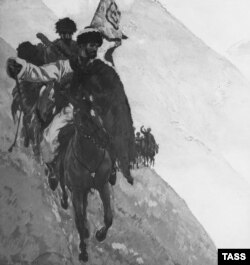The skull of the legendary Caucasian warrior Hadji Murad -- who was beheaded by Russian troops in the 19th century -- is one step closer to being returned to his relatives in Daghestan, Russian officials say.
Known as the Red Devil by his Russian foes for his red clothes and daring fighting, Hadji Murad battled tsarist forces with fellow legend Imam Shamil in the Caucasian War for decades, though he also switched sides and joined his longtime Russian enemies, who eventually detained and killed him in 1852.
But the long battle for the fearless Avar’s head -- kept in St. Petersburg’s famously freaky Kunstkamera museum for several decades -- seems to finally be moving toward a resolution.
Vladimir Tolstoy --a great-great-grandson of Russian writer Leo Tolstoy -- announced on January 21 that the Russian presidential commission that he leads had agreed, “in general,” to support the return of Murad’s skull to the Russian republic of Daghestan, where he was born.
Tolstoy added that after consulting with the Daghestani government, the committee had decided to hand over Murad’s remains to officials in Makhachkala at a “later” date, “taking into account the current internal political situation in the republic.” It's unclear exactly what Tolstoy was referring to, but violence is common in Daghestan, where Islamic militants mount frequent attacks against police, public officials, and moderate Muslims.
Tolstoy's committee was formed in November 2015 by order of the Russian Culture Ministry and charged with verifying Murad's remains as well as deciding on the specifics of their return and burial.
Magomedarip Hadzhimuradov, a great-grandson of Murad who has been designated as his primary heir, has said it was the “dream of his ancestors” to bury his famous relative’s skull “with his remains,” which lie in a poorly maintained grave in the northern Azerbaijani district of Qakh, close to where he was killed and not far from Azerbaijan’s borders with Daghestan and Georgia.
Long Time Coming
Hadzhimuradov says his relatives first sought the return of their ancestor's skull from Soviet authorities in the 1930s. But he, activists, and many of Murad’s other relatives also petitioned the Kremlin in 2017.
That was followed later that year by a strong appeal from mercurial Chechen leader Ramzan Kadyrov, who first called for Russian officials to bury the mummified body of Vladimir Lenin while also requesting that Murad’s head be returned to the Caucasus where it, too, could be properly laid to rest.
"Both Lenin's body as well as that of Hadji Murat...whose head is to this day kept in a museum in St. Petersburg -- should be buried," he said.
Kadyrov's widely publicized call did not sit well with many Daghestanis, who saw it as unwanted interference in their republic's affairs.
"Solving the reunification of the remains of Hadji Murat and their burial is the prerogative of his descendants," said Magomedrasul Magomedrasulov, a representative of the Leo Tolstoy and Daghestan Heritage Committee.
Murad is viewed by many as a national hero in the North Caucasus, a region that has been wracked by Islamic extremist violence, corruption, and poverty since the fall of the Soviet Union.
Many see the return and possible celebratory reuniting of Murad’s head with his body in a remote part of Azerbaijan -- a move that his relatives support -- as a way to bring tourism to the area.
“If this monument is included on the list of tourist sites, it will definitely become popular with visitors given Hadji Murad’s historic significance and that he was Tolstoy’s character [in a famous book],” Natiq Mantash, an Azerbaijani historian, told the Caucasian Knot website.
Tolstoy Favorite
Leo Tolstoy mythologized Hadji Murad with tales of wondrous fighting and grand escapes when he wrote the eponymous novella about him, published in 1912, two years after the legendary Russian writer’s death.
The book was seen as pointedly critical of Russia’s decades-long, bloody takeover of the Caucasus and made Tolstoy a beloved personality in the region, where he has towns named after him and societies and museums devoted to him.
As Maria Dmitriyevna, a character in Tolstoy’s fictional story said after seeing Russian soldiers reveling at the sight of Murad’s bloody head: “You are butchers, and that’s all there is to it. A dead body should be decently buried and they make mock of it.”
But the idea of allowing the skull to return for burial in the Caucasus does not have everyone’s approval.
Magomedrasulov told RFE/RL late last year that a member of the Russian Academy of Sciences had queried: “Is there any guarantee that people will fill dozens of buses and be proclaiming 'Allahu Akbar!' as they go to visit [Hadji Murad’s] tomb?"
Others suggested that the site of a reburied Hadji Murad could serve as a place of homage for extremists.
Official Azerbaijan has been silent about any possible burial, wary of stirring up ethnic tensions in a part of the country with a large population of Lezgins and Avars, the same ethnic group as Murad.
The Kunstkamera, which was founded by Peter the Great in the 18TH century, has a recent precedent in returning the skull of a famous rebel against Russian rule.
After years of unfulfilled requests by his relatives, Russian officials in 2016 returned the head of Kazakh nationalist leader Keiki Batyr.
Also known as Nurmaghanbet Kokembaiuly, Batyr was a main leader of the Kazakh uprising against tsarist Russia in 1916.
Killed by the Bolsheviks in 1923, he was beheaded and his skull sent to St. Petersburg and the Kunstkamera’s ghoulish exhibit.
In 1991, the museum said it held 457 skulls in its collection, many of them chopped-off heads of ethnic group leaders vanquished by Russian forces and given to tsars as proof of their death.
But the descendants of Hadji Murad are hopeful there will soon be one less Russian trophy-head in the St. Petersburg museum.
“I hope [this dream of my ancestors and mine for his skull to be returned to us] will become a reality before I leave this world,” the elderly Hadzhimuradov told journalists in Makhachkala in November 2018.














